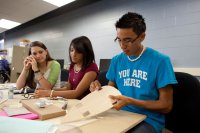Starting Small With Maker Education
Schools don’t need a lot of money or a dedicated space to try maker education—a cart with some basic materials will suffice.
Your content has been saved!
Go to My Saved Content.Most educators are already familiar with the popular idea of makerspaces and context-based learning. However, it’s unlikely that most educators are part of educational communities that have the resources, time, and staffing to successfully construct and use a fully equipped makerspace, which are expensive to construct and staff—and even when school communities manage to create them, they can be intimidating for students and faculty alike.
Mobile maker carts are an accessible, affordable way to empower teachers to experiment with small maker-minded projects. They enable students to practice the habits of mind associated with maker learning, without the intimidation or expense associated with creating a designated space.
We are two ELA teachers at an independent school with approximately 350 middle and high school students. At the beginning of this year, we were tasked with conceptualizing, launching, and facilitating the use of maker carts in our school community. After introducing them in our school, we’ve seen a huge increase in faculty and student innovation.
With the following ideas, we hope to provide other teachers with practical strategies for setting up a maker cart system to promote this kind of pedagogy in their own schools.
Setting Up a Maker Cart System
The first step is finding a central space to store the carts. We began with four carts that we stored in a corner of a small, locked office. This provided us with easy access to the resources and control over their distribution.
Assembling the supplies is the next step. At the start of the school year, we bought a range of ready-to-go resources, including:
- Construction materials: glue guns, pipe cleaners, poster board, construction paper, wooden dowels, etc.
- Decorative materials: sequins, fabric, yarn, ribbon, pens and pencils, beads, feathers, etc.
- Sewing and painting tools: paintbrushes, paints, sewing thread, needles (these need to be used under careful supervision)
- Storage boxes to organize materials
The total came to $350, which we covered using grant money. Throughout the rest of the school year, we spent another $300 to replenish supplies and order additional materials, such as styrofoam balls and Velcro strips, by request.
Next, we created a system for teachers to order carts for their classrooms:
- Teachers accessed a designated folder on a shared digital drive, which had a portfolio of subject-specific maker project ideas and photos of completed projects. It also had an order form to propose projects and materials from a menu—we also had an option to add materials to the list.
- Teachers met with one of us to discuss their project and needs.
- We assembled the cart and delivered it at the requested time. We also arranged the pickup time.
For our school community, this system has proved simple and affordable, and during this first year, we have seen teachers across the disciplines using maker-minded learning in new and exciting ways.
Sample Projects
Here are a few projects teachers have completed.
Water Duct Project in a Hydrology Elective: Teams of 11th- and 12th-grade students were given specific materials to design water ducts. The task was to transport water from one end of the model to the other without leakage. They were graded on characteristics of their models such as aesthetics and speed of water transfer. The project concluded in a presentation, which included an explanation and a demonstration.
Clothesline Argumentative Essay in English: Ninth-grade students were given an essay question and tasked with mapping out their responses according to the structure of a clothesline. The posts at either end of the line represented the introduction and conclusion, the clothespins represented the topic sentences, the clothes represented the paragraphs, and the clothesline represented the thesis connecting the entire essay. The class worked together to create the argument; then, in collaborative teams, students worked on different parts of the clothesline. They then assembled their piece on the model, and the teacher facilitated a discussion of the logic, clarity, and structure of their final product.
Pasta Classification in Life Sciences: In this project, sixth-grade students were taught to understand how organisms are ordered into taxa. They worked in groups to classify different pasta shapes according to characteristics such as color, size, and texture. It was up to the groups themselves to design their own organizational systems.
Our experience demonstrates that maker-minded learning does not require state-of-the-art equipment or particularly tech-savvy faculty and students. By scaling the makerspace concept to a manageable scope, maker carts can unleash new, creative ways of learning.
